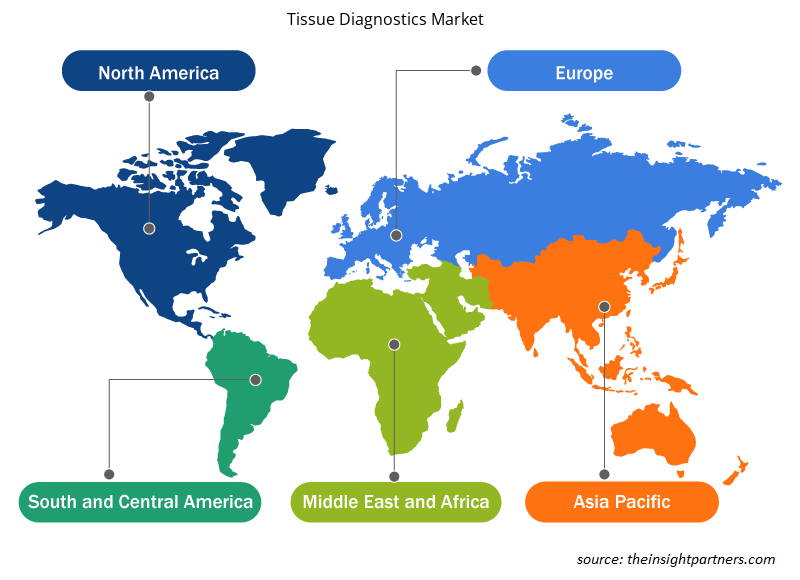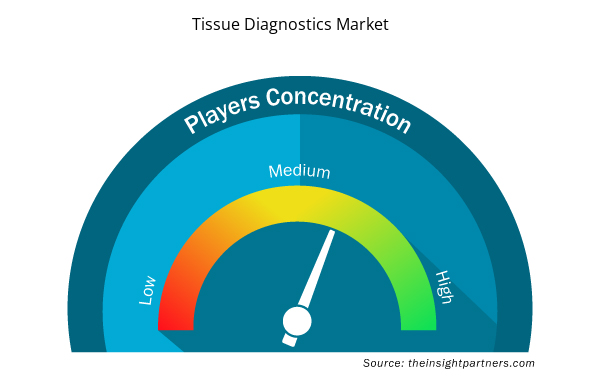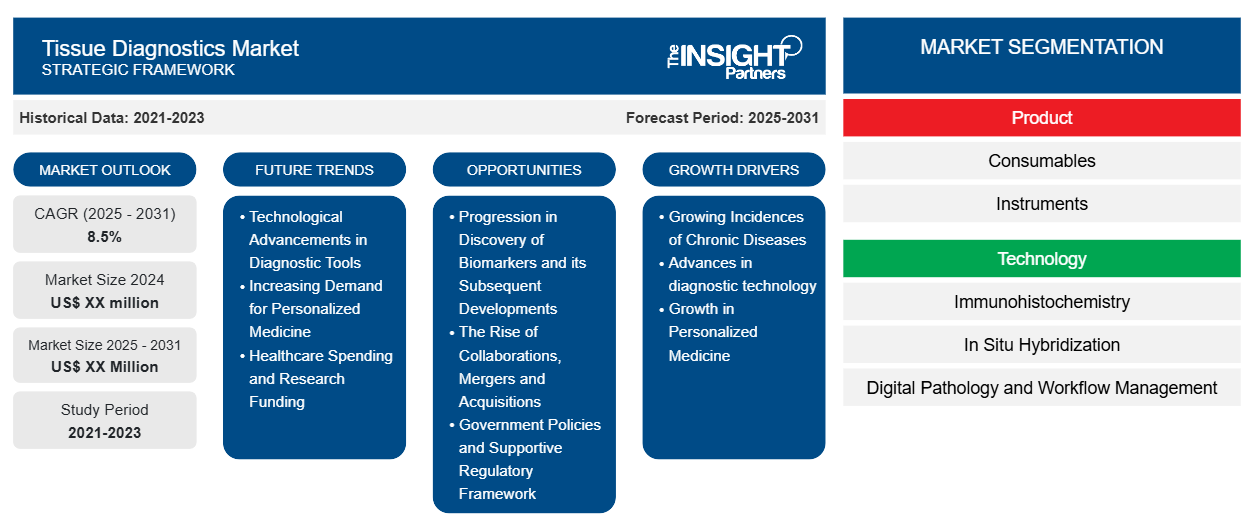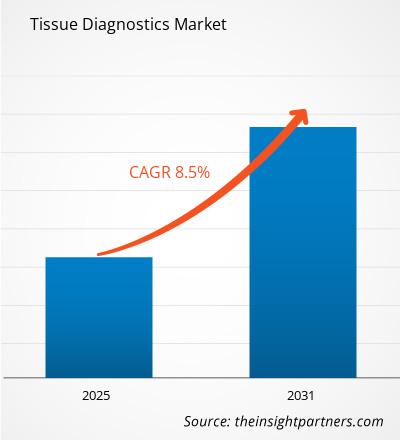Der Markt für Gewebediagnostik wird voraussichtlich von 2024 bis 2031 eine durchschnittliche jährliche Wachstumsrate (CAGR) von 8,5 % verzeichnen, wobei die Marktgröße von XX Millionen US-Dollar im Jahr 2024 auf XX Millionen US-Dollar im Jahr 2031 wachsen wird.
Der Bericht ist nach Produkt (Verbrauchsmaterialien und Instrumente) segmentiert. Der Bericht ist nach Technologie (Immunhistochemie (IHC), In-situ-Hybridisierung (ISH), digitale Pathologie und Workflow-Management und Spezialfärbung) segmentiert. Der Bericht ist nach Krankheit (Brustkrebs, Magenkrebs, Lymphom, Prostatakrebs, nicht-kleinzelliger Lungenkrebs (NSCLC) und andere Krankheiten) segmentiert. Der Bericht ist nach Endbenutzer (Krankenhäuser, Forschungslabore, Pharmaunternehmen, Auftragsforschungsinstitute und andere) segmentiert. Die globale Analyse ist weiter auf regionaler Ebene und nach wichtigen Ländern aufgeschlüsselt. Der Bericht bietet den Wert in USD für die oben genannte Analyse und Segmente.
Zweck des Berichts
Der Bericht Tissue Diagnostics Market von The Insight Partners zielt darauf ab, die aktuelle Situation und das zukünftige Wachstum sowie die wichtigsten treibenden Faktoren, Herausforderungen und Chancen zu beschreiben. Dies wird verschiedenen Geschäftspartnern Einblicke geben, wie zum Beispiel:
- Technologieanbieter/-hersteller: Um die sich entwickelnde Marktdynamik zu verstehen und die potenziellen Wachstumschancen zu kennen, damit sie fundierte strategische Entscheidungen treffen können.
- Investoren: Durchführung einer umfassenden Trendanalyse hinsichtlich der Marktwachstumsrate, der finanziellen Marktprognosen und der Chancen entlang der Wertschöpfungskette.
- Regulierungsbehörden: Zur Regulierung von Richtlinien und Überwachungsaktivitäten auf dem Markt mit dem Ziel, Missbrauch zu minimieren, das Vertrauen der Anleger zu bewahren und die Integrität und Stabilität des Marktes aufrechtzuerhalten.
Marktsegmentierung für Gewebediagnostik
Produkt
- Verbrauchsmaterial
- Instrumente
Technologie
- Immunhistochemie
- In-situ-Hybridisierung
- Digitale Pathologie und Workflow-Management
- Spezialfärbung
Krankheit
- Brustkrebs
- Magenkrebs
- Lymphom
- Prostatakrebs
- Nicht-kleinzelliger Lungenkrebs
- Andere Krankheiten
Endbenutzer
- Krankenhäuser
- Forschungslabore
- Pharmaunternehmen
- Auftragsforschungsinstitute
- Sonstiges
Passen Sie diesen Bericht Ihren Anforderungen an
Sie erhalten kostenlos individuelle Anpassungen an jedem Bericht, einschließlich Teilen dieses Berichts oder einer Analyse auf Länderebene, eines Excel-Datenpakets sowie tolle Angebote und Rabatte für Start-ups und Universitäten.
- Holen Sie sich die wichtigsten Markttrends aus diesem Bericht.Dieses KOSTENLOSE Beispiel umfasst eine Datenanalyse von Markttrends bis hin zu Schätzungen und Prognosen.
Wachstumstreiber auf dem Markt für Gewebediagnostik
- Growing Incidences of Chronic Diseases: One of the major market growth drivers in the tissue diagnostics industry is the growing incidence of chronic diseases, especially cancer. As per World Health Organization, there are some deaths caused due to cancer in the world. With an aging world population, the incidence of chronic diseases, including cancer, will steadily increase; therefore, the demand for advanced diagnostic tools that are more precise and occur earlier will significantly increase. Tissue diagnostics is also increasingly implemented in cancer detection because it enables pathologists to differentiate various types of tumors and stages of cancers for positive decisions.
- Advances in diagnostic technology: This is due to continually emerging diagnostic technologies that change the face of tissue diagnostics. For example, next-generation sequencing (NGS), molecular diagnostics, and digital pathology have ensured diseases are diagnosed accurately, rapidly, and non-invasively. An example in this regard is how digital pathology allows for remote conferencing for pathologists while examining high-resolution digital images of tissue samples. Improved accuracy comes with a likelihood of more personalized treatments hence further pushing the market.
- Growth in Personalized Medicine: Another leading factor increasing the demand for tissue diagnostics is the growth in personalized medicine. Personalized medicine is that form of treatment that is tailored according to the genetic makeup of an individual. Personalized medicine requires very accurate molecular and genetic examination of tissue samples. The growing interest in precision medicine provides a growing need for sophisticated diagnostic equipment in the tissue diagnostics arena. It enables the evaluation of particular mutations or biomarkers in cancerous tissues and enhances treatment choice and patient results while minimizing unnecessary treatments.
Tissue Diagnostics Market Future Trends
- Technological Advancements in Diagnostic Tools: Increasing the high-tech diagnostic tools and techniques has constantly been changing the face of tissue diagnostics. Techniques such as next-generation sequencing, molecular diagnostics, and digital pathology can increase precision, speed, and less invasiveness in making a diagnosis. This allows pathologists to see digital images of tissue specimens at high-resolution levels, thus reducing the complexity of the process and fostering e-consultation among specialists. All these advances are expected to make diagnoses more accurate and lead to more targeted treatments, so yet again, the market will be spurred forward.
- Increasing Demand for Personalized Medicine: Another major growth driver of the tissue diagnostics market is the adoption of personalized medicine. In the field of personalized medicine, tissue diagnostics is usually dependent on the very precise molecular and genetic analysis of tissue samples. It is very apparent that advanced tissue diagnostics would be in high demand with the progress of precision medicine. The evaluation of tumor tissues for specific biomarkers or mutations aids clinicians in making a better choice regarding most appropriate therapies and would also reduce unnecessary treatment, hence healthy patient outcomes.
- Healthcare Spending and Research Funding: Around the world, governments and healthcare organizations are investing heavily in healthcare infrastructure and research, especially in oncology and disease diagnosis. This investment culminates in better and newer diagnostic tools and technologies as well as more tissue diagnostics for emerging markets. As the healthcare systems continue to modernize and become disease preventive in nature, the need for tissue diagnostics continues to grow due to the increasing need to offer a better solution for the detection and management of diseases.
Tissue Diagnostics Market Opportunities
- Progression in Discovery of Biomarkers and its Subsequent Developments: The process and finding new markers for measuring different diseases, more so cancers, is a very big call for the players in the tissue diagnosis business. As the scientists discover more specific markers for a diagnosis, test for them will surely improve, in which ways will diagnose earlier, provide the prognosis more accurately and most importantly treatment will be more of targeted therapy. This paves way for new products and services as far as diagnosis is concerned.
- The Rise of Collaborations, Mergers and Acquisitions: Collaboration amongst researchers from universities, innovative biotech organizations and drug research companies provides an opportunity to speed up the development of more advanced tissue diagnostic methods. It is these combinations that cross such frontiers creating advances in tissue diagnostics, especially where molecular and genetic assays for disease are concerned, and enhancement of treatment accuracy.
- Government Policies and Supportive Regulatory Framework: Advanced Maternal Age Reproductive Health Treatment in most countries, this policy and secondary policies are aimed at very efficient use of healthcare system with cost saving and cost containment. In this regard implementation of such advanced tissue diagnostic services is likely to remove the barriers to entry that the present and potential market players in tissue diagnostics may be facing.
Tissue Diagnostics Market Regional Insights
The regional trends and factors influencing the Tissue Diagnostics Market throughout the forecast period have been thoroughly explained by the analysts at Insight Partners. This section also discusses Tissue Diagnostics Market segments and geography across North America, Europe, Asia Pacific, Middle East and Africa, and South and Central America.

- Get the Regional Specific Data for Tissue Diagnostics Market
Tissue Diagnostics Market Report Scope
| Report Attribute | Details |
|---|---|
| Market size in 2024 | US$ XX million |
| Market Size by 2031 | US$ XX Million |
| Global CAGR (2025 - 2031) | 8.5% |
| Historical Data | 2021-2023 |
| Forecast period | 2025-2031 |
| Segments Covered | By Product
|
| Regions and Countries Covered | North America
|
| Market leaders and key company profiles |
|
Tissue Diagnostics Market Players Density: Understanding Its Impact on Business Dynamics
The Tissue Diagnostics Market market is growing rapidly, driven by increasing end-user demand due to factors such as evolving consumer preferences, technological advancements, and greater awareness of the product's benefits. As demand rises, businesses are expanding their offerings, innovating to meet consumer needs, and capitalizing on emerging trends, which further fuels market growth.
Market players density refers to the distribution of firms or companies operating within a particular market or industry. It indicates how many competitors (market players) are present in a given market space relative to its size or total market value.
Major Companies operating in the Tissue Diagnostics Market are:
- Thermo Fisher Scientific
- Danaher
- Becton, Dickinson, and Company
- Agilent Technologies
- Abbott
Disclaimer: The companies listed above are not ranked in any particular order.

- Get the Tissue Diagnostics Market top key players overview
Key Selling Points
- Comprehensive Coverage: The report comprehensively covers the analysis of products, services, types, and end users of the Tissue Diagnostics Market, providing a holistic landscape.
- Expert Analysis: The report is compiled based on the in-depth understanding of industry experts and analysts.
- Up-to-date Information: The report assures business relevance due to its coverage of recent information and data trends.
- Customization Options: This report can be customized to cater to specific client requirements and suit the business strategies aptly.
Der Forschungsbericht zum Markt für Gewebediagnostik kann daher dabei helfen, die Branchensituation und Wachstumsaussichten zu entschlüsseln und zu verstehen. Obwohl es einige berechtigte Bedenken geben kann, überwiegen die allgemeinen Vorteile dieses Berichts tendenziell die Nachteile.
- Historische Analyse (2 Jahre), Basisjahr, Prognose (7 Jahre) mit CAGR
- PEST- und SWOT-Analyse
- Marktgröße Wert/Volumen – Global, Regional, Land
- Branche und Wettbewerbsumfeld
- Excel-Datensatz


- Surety Market
- Fish Protein Hydrolysate Market
- Visualization and 3D Rendering Software Market
- Workwear Market
- Electronic Health Record Market
- Health Economics and Outcome Research (HEOR) Services Market
- Smart Parking Market
- Embolization Devices Market
- Artificial Intelligence in Healthcare Diagnosis Market
- Medical Audiometer Devices Market

Report Coverage
Revenue forecast, Company Analysis, Industry landscape, Growth factors, and Trends

Segment Covered
This text is related
to segments covered.

Regional Scope
North America, Europe, Asia Pacific, Middle East & Africa, South & Central America

Country Scope
This text is related
to country scope.
Häufig gestellte Fragen
Consumables segment, by product, dominated the market in 2023.
Players operating in the market are Thermo Fisher Scientific, Danaher, Becton, Dickinson, and Company, Agilent Technologies, Abbott, Roche, Merck KGaA, Biogenex, Hologic Inc., Qiagen
North America region dominated the Tissue Diagnostics market in 2023.
Progression in Discovery of Biomarkers and its Subsequent Developments act as a opportunity for growth of the market in forecast period.
The Tissue Diagnostics Market is estimated to witness a CAGR of 8.5% from 202#to 2031
The major factors driving the Tissue Diagnostics market are:
1. Advances in diagnostic technology
2. Growth in Personalized Medicine
Trends and growth analysis reports related to Life Sciences : READ MORE..
The List of Companies
- Thermo Fisher Scientific
- Danaher
- Becton, Dickinson, and Company
- Agilent Technologies
- Abbott
- Roche
- Merck KGaA
- Biogenex
- Hologic Inc.
- Qiagen
The Insight Partners performs research in 4 major stages: Data Collection & Secondary Research, Primary Research, Data Analysis and Data Triangulation & Final Review.
- Data Collection and Secondary Research:
As a market research and consulting firm operating from a decade, we have published and advised several client across the globe. First step for any study will start with an assessment of currently available data and insights from existing reports. Further, historical and current market information is collected from Investor Presentations, Annual Reports, SEC Filings, etc., and other information related to company’s performance and market positioning are gathered from Paid Databases (Factiva, Hoovers, and Reuters) and various other publications available in public domain.
Several associations trade associates, technical forums, institutes, societies and organization are accessed to gain technical as well as market related insights through their publications such as research papers, blogs and press releases related to the studies are referred to get cues about the market. Further, white papers, journals, magazines, and other news articles published in last 3 years are scrutinized and analyzed to understand the current market trends.
- Primary Research:
The primarily interview analysis comprise of data obtained from industry participants interview and answers to survey questions gathered by in-house primary team.
For primary research, interviews are conducted with industry experts/CEOs/Marketing Managers/VPs/Subject Matter Experts from both demand and supply side to get a 360-degree view of the market. The primary team conducts several interviews based on the complexity of the markets to understand the various market trends and dynamics which makes research more credible and precise.
A typical research interview fulfils the following functions:
- Provides first-hand information on the market size, market trends, growth trends, competitive landscape, and outlook
- Validates and strengthens in-house secondary research findings
- Develops the analysis team’s expertise and market understanding
Primary research involves email interactions and telephone interviews for each market, category, segment, and sub-segment across geographies. The participants who typically take part in such a process include, but are not limited to:
- Industry participants: VPs, business development managers, market intelligence managers and national sales managers
- Outside experts: Valuation experts, research analysts and key opinion leaders specializing in the electronics and semiconductor industry.
Below is the breakup of our primary respondents by company, designation, and region:

Once we receive the confirmation from primary research sources or primary respondents, we finalize the base year market estimation and forecast the data as per the macroeconomic and microeconomic factors assessed during data collection.
- Data Analysis:
Once data is validated through both secondary as well as primary respondents, we finalize the market estimations by hypothesis formulation and factor analysis at regional and country level.
- Macro-Economic Factor Analysis:
We analyse macroeconomic indicators such the gross domestic product (GDP), increase in the demand for goods and services across industries, technological advancement, regional economic growth, governmental policies, the influence of COVID-19, PEST analysis, and other aspects. This analysis aids in setting benchmarks for various nations/regions and approximating market splits. Additionally, the general trend of the aforementioned components aid in determining the market's development possibilities.
- Country Level Data:
Various factors that are especially aligned to the country are taken into account to determine the market size for a certain area and country, including the presence of vendors, such as headquarters and offices, the country's GDP, demand patterns, and industry growth. To comprehend the market dynamics for the nation, a number of growth variables, inhibitors, application areas, and current market trends are researched. The aforementioned elements aid in determining the country's overall market's growth potential.
- Company Profile:
The “Table of Contents” is formulated by listing and analyzing more than 25 - 30 companies operating in the market ecosystem across geographies. However, we profile only 10 companies as a standard practice in our syndicate reports. These 10 companies comprise leading, emerging, and regional players. Nonetheless, our analysis is not restricted to the 10 listed companies, we also analyze other companies present in the market to develop a holistic view and understand the prevailing trends. The “Company Profiles” section in the report covers key facts, business description, products & services, financial information, SWOT analysis, and key developments. The financial information presented is extracted from the annual reports and official documents of the publicly listed companies. Upon collecting the information for the sections of respective companies, we verify them via various primary sources and then compile the data in respective company profiles. The company level information helps us in deriving the base number as well as in forecasting the market size.
- Developing Base Number:
Aggregation of sales statistics (2020-2022) and macro-economic factor, and other secondary and primary research insights are utilized to arrive at base number and related market shares for 2022. The data gaps are identified in this step and relevant market data is analyzed, collected from paid primary interviews or databases. On finalizing the base year market size, forecasts are developed on the basis of macro-economic, industry and market growth factors and company level analysis.
- Data Triangulation and Final Review:
The market findings and base year market size calculations are validated from supply as well as demand side. Demand side validations are based on macro-economic factor analysis and benchmarks for respective regions and countries. In case of supply side validations, revenues of major companies are estimated (in case not available) based on industry benchmark, approximate number of employees, product portfolio, and primary interviews revenues are gathered. Further revenue from target product/service segment is assessed to avoid overshooting of market statistics. In case of heavy deviations between supply and demand side values, all thes steps are repeated to achieve synchronization.
We follow an iterative model, wherein we share our research findings with Subject Matter Experts (SME’s) and Key Opinion Leaders (KOLs) until consensus view of the market is not formulated – this model negates any drastic deviation in the opinions of experts. Only validated and universally acceptable research findings are quoted in our reports.
We have important check points that we use to validate our research findings – which we call – data triangulation, where we validate the information, we generate from secondary sources with primary interviews and then we re-validate with our internal data bases and Subject matter experts. This comprehensive model enables us to deliver high quality, reliable data in shortest possible time.


 Holen Sie sich ein kostenloses Muster für diesen Bericht
Holen Sie sich ein kostenloses Muster für diesen Bericht